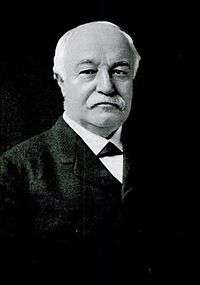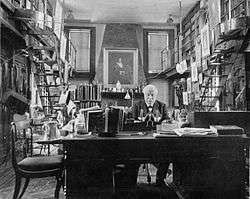Horace Howard Furness
| Horace Howard Furness | |
|---|---|
 | |
| Born |
November 2, 1833 Philadelphia, Pennsylvania |
| Died |
August 13, 1912 Wallingford, Pennsylvania |
| Spouse(s) | Helen Kate (Rogers) Furness |
| Children |
Walter Rogers Furness Horace Howard Furness Jr. William Henry Furness III Caroline Augusta (Furness) Jayne |
| Parent(s) |
William Henry Furness Annis Pulling (Jenks) Furness |
Horace Howard Furness (November 2, 1833 – August 13, 1912) was an American Shakespearean scholar of the 19th century.
Life and career

Horace Furness was the son of the Unitarian minister and abolitionist William Henry Furness (1802–1896), and brother of the architect Frank Furness (1839–1912). He graduated from Harvard University in 1854, then studied in Germany.[2] After returning to the United States, he was admitted to the Philadelphia Bar in 1859, but his growing deafness interfered with the practice of law.[3] He married Helen Kate Rogers, sister of Fairman Rogers, and heir to an ironmaking fortune. They had four children.
In 1860, he joined the Shakspere [sic] Society of Philadelphia, an amateur study group that took its scholarship seriously. As he later wrote:
"Every member had a copy of the Variorum of 1821, which we fondly believed had gathered under each play all Shakespearian lore worth preserving down to that date. What had been added since that year was scattered in many different editions, and in numberless volumes dispersed over the whole domain of literature. To gather these stray items of criticism was real toil, real but necessary if we did not wish our labour over the text to be in vain."[4]
As editor of the "New Variorum" editions of Shakespeare—also called the "Furness Variorum"—he collected in a single source 300 years of references, antecedent works, influences and commentaries. He devoted more than forty years to the series, completing the annotation of sixteen plays. With his wife, Helen Kate Furness (1837–1883), he authored A Concordance to Shakespeare's Poems (1874). His son, Horace Howard Furness, Jr. (1865–1930), joined as co-editor of the Variorum's later volumes, and continued the project after the father's death, annotating three additional plays and revising two others.
He was a lecturer at the University of Pennsylvania, a long-serving trustee (1880–1904), and chairman of the building committee for its library. Designed by his brother Frank, Horace selected the Shakepearean quotes for the 1891 building's leaded glass windows.[5] He was the advisor for doctoral student Emily Jordan Folger who, with her husband Henry Clay Folger, would co-found the Folger Shakespeare Library in Washington, DC.[6]
An 1890 review in Blackwood's Magazine may indicate the esteem in which British critics held Furness's scholarship:
"In what is called 'The Variorum Edition of Shakespeare,' America has the honor of having produced the very best and most complete edition, so far as it has gone, of our great national poet. For text, illustration (happily, not pictorial), commentary and criticism, it leaves nothing to be desired. The editor combines with the patience and accuracy of the textural scholar, an industry which has overlooked nothing of value that has been written about Shakespeare by the best German and French, as well as English commentators and critics; and what is of no less moment he possesses in himself a rare delicacy of literary appreciation and breadth of judgment, disciplined by familiarity with all that is best in the literature of antiquity as well as of modern times, which he brings to bear on his notes with great effect."[7]
New Variorum
_p333.jpg)
Volumes edited by Horace Howard Furness
- Romeo and Juliet (published 1871)
- Macbeth (1873)
- Hamlet vol. 1 (1877)
- Hamlet vol. 2 (1877)
- King Lear (1880)
- Othello (1886)
- Merchant of Venice (1888)
- As You Like It (1890)
- The Tempest (1892)
- A Midsummer Night's Dream (1895)
- The Winter's Tale (1898)
- Twelfth Night (1901)
- Much Ado About Nothing (1904)
- Love's Labors Lost (1904)
- Anthony and Cleopatra (1907)
- Richard III (1908)
- Cymbeline (1913) (published posthumously)
Volumes edited by H. H. Furness, Jr.
- Julius Caesar (1913)[8]
- Macbeth (revised)
- Merchant of Venice (revised)
- King John (1919)
- Coriolanus (1928)
The Modern Language Association of America continues the "New Variorum" project with the goal of definitively annotating all 38 of Shakespeare's plays.[9]
Honors
Furness was elected to membership in the American Philosophical Society in 1880.[10] He was the recipient of honorary degress from Harvard University, University of Halle, University of Pennsylvania, Columbia University, and University of Cambridge.[11] He was elected a member of the American Academy of Arts and Letters in 1905.[12]
Legacy
- Horace Howard Furness High School in South Philadelphia is named for him.
- Horace Jr. donated his father's Shakespearean collection to the University of Pennsylvania, whose Horace Howard Furness Memorial Library honors both father and son.[13]
- Another son, William Henry Furness III, was one of the University of Pennsylvania medical students depicted in Thomas Eakins's painting The Agnew Clinic (1889).[14] He undertook anthropological expeditions with Hiram M. Hiller, Jr. and Alfred C. Harrison, Jr., and wrote books and articles about Borneo and Southeast Asia.
- W.H. Furness III donated the land for the Helen Kate Furness Free Library in Wallingford, Pennsylvania,[15] built on the former grounds of the family's country house, "Lindenshade."
 "Lindenshade", Wallingford, Pennsylvania (built c. 1873, demolished 1940), attributed to Frank Furness.
"Lindenshade", Wallingford, Pennsylvania (built c. 1873, demolished 1940), attributed to Frank Furness.- The University of Pennsylvania Library (1891), now the Fisher Fine Arts Library.
- Leaded glass fanlight above the main entrance to the University of Pennsylvania Library.
- Horace Howard Furness High School in South Philadelphia.
- Helen Kate Furness Free Library, Providence Road & Furness Lane, Wallingford, PA.
References
- ↑ Historic American Buildings Survey PA.23-WALF.2A-5, Library of Congress.
- ↑ Thomas Wentworth Higginson, "Horace Howard Furness," Harvard Memorial Biographies, Volume 1.
- ↑ Lang, Harry (1995). Deaf Persons in the Arts and Sciences: A Biographical Dictionary. Greenwood Publishing Group. p. 136. ISBN 0313291705.
- ↑ Horace Howard Furness, "How did you become a Shakespeare Student?" Shakespeariana, vol. 5 (October 1888), pp. 439-40.
- ↑ Following a 6-year restoration, Frank Furness's University of Pennsylvania Library was rededicated in 1991, on the occasion of its centennial, as the Fisher Fine Arts Library.
- ↑ Joseph Quincy Adams and Paul Cret, The Folger Shakespeare Library, Washington (Amherst College, 1933).
- ↑ Quoted in "Horace Howard Furness," Dictionary of Literary Biography (Thomson Gale, 2005-06)
- ↑ Julius Caesar New Variorum text
- ↑ New Variorum continues ...
- ↑ American Philosophical Society Member History
- ↑ Horace Howard Furness from Historical Society of Pennsylvania.
- ↑ Deceased Members from American Academy of Arts and Letters.
- ↑ Horace Howard Furness Memorial Library
- ↑ Wm. H. Furness III is the student at the top center of the painting, leaning sideways to get a better look.File:Thomas Eakins, The Agnew Clinic 1889.jpg
- ↑ Helen Kate Furness Free Library
Further reading
- Gibson, James M. The Philadelphia Shakespeare Story: Horace Howard Furness and the New Variorum Shakespeare (New York: AMS Press, 1990)
- Repplier, Agnes, "Horace Howard Furness," The Atlantic Monthly, November 1912.
- Williams, Talcott, "Appreciations of Horace Howard Furness: Our Great Shakespeare Critic," The Century Magazine, November 1912.
External links
| Wikimedia Commons has media related to Horace Howard Furness. |
| Library resources about Horace Howard Furness |
| By Horace Howard Furness |
|---|
-
 "Furness, Horace Howard". Encyclopædia Britannica (11th ed.). 1911.
"Furness, Horace Howard". Encyclopædia Britannica (11th ed.). 1911. - The Horace Howard Furness collection on the Great Central Fair, containing Furness' papers and ephemera from the U.S. Sanitary Commission's Great Central Fair in 1864, are available for research use at the Historical Society of Pennsylvania.
- The Furness Library and the papers of the Furness family are located at the Kislak Center for Special Collections, Rare Books and Manuscripts at the University of Pennsylvania.